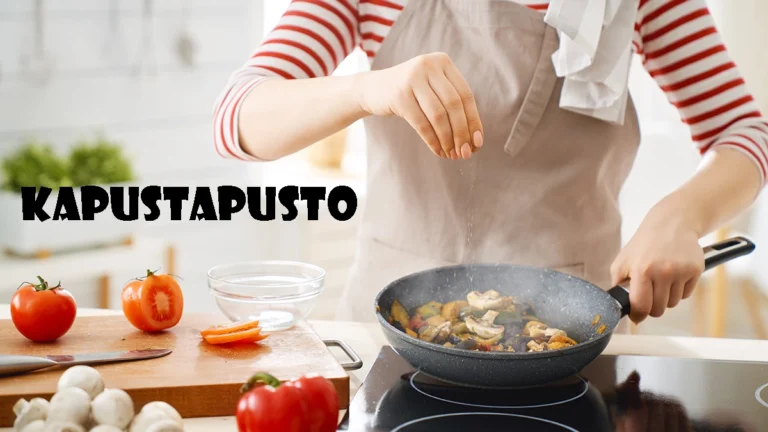Embark on a culinary adventure like no other with Kapustapusto. This delightful variation of the traditional cabbage rolls promises to take your taste buds on a tantalizing journey through the rich and diverse flavors of Eastern European cuisine. From its humble origins rooted deeply in tradition to its modern reinvention, Kapustapusto offers a savory experience that captivates both palate and imagination. Join us as we delve into the essence of this beloved dish, exploring its cultural significance, its unique ingredients, and the artistry behind its preparation. Get ready to indulge in a symphony of tastes and aromas as we uncover the secrets of Kapustapusto and celebrate the culinary heritage of Eastern Europe.
Unveiling Kapustapusto’s Essence
Kapustapusto, with its rich history and distinct flavors, embodies the very essence of Eastern European cuisine. Rooted in tradition, this beloved dish offers a tantalizing blend of ingredients and techniques that have been passed down through generations. At its core, Kapus-tapusto represents the spirit of community and celebration, bringing people together over a shared love for hearty, flavorful food.
Exploring Kapustapusto’s Origins
The origins of Kapustapusto trace back to the heart of Eastern Europe, where cabbage was plentiful and culinary creativity thrived. This iconic dish emerged as a way to make the most of simple ingredients, combining cabbage, meat, rice, and spices in a harmonious marriage of flavors. Over time, Kapus-tapusto evolved, adapting to regional preferences and culinary innovations while retaining its timeless appeal.
Traditional Ingredients & Techniques
Kapustapusto’s traditional recipe boasts a symphony of flavors derived from its core ingredients: tender cabbage leaves, savory ground meat, aromatic spices, and fragrant rice. The preparation process is an art form in itself, requiring skillful rolling and simmering to achieve the perfect balance of textures and tastes. Each step is imbued with care and tradition, resulting in a dish that delights the senses and warms the soul.
Evolution of Kapustapusto
While rooted in tradition, Kapustapusto has evolved over time, adapting to changing tastes and culinary trends. Modern variations may incorporate innovative ingredients or cooking methods, adding new dimensions to this classic dish while honoring its heritage. Despite these adaptations, Kapus-tapusto remains a beloved symbol of Eastern European cuisine, cherished for its timeless appeal and enduring deliciousness.
Culinary Adventure through Eastern Europe
Embarking on a culinary adventure through Eastern Europe would be incomplete without savoring the delights of Kapustapusto. From the rolling hills of Hungary to the bustling streets of Poland, this iconic dish can be found in various forms, each reflecting the unique cultural heritage of its region. Exploring the diverse interpretations of Kapus-tapusto offers a glimpse into the rich tapestry of Eastern European cuisine, where tradition meets innovation in every bite.
Mastering Kapustapusto Preparation
Mastering the art of Kapustapusto preparation requires patience, precision, and a deep appreciation for tradition. From selecting the freshest cabbage to perfectly seasoning the filling, every step plays a crucial role in achieving culinary perfection. With practice and dedication, aspiring chefs can hone their skills and create Kapus-tapusto that rivals even the most seasoned cooks.
Cultural Significance of Kapustapusto
Kapustapusto holds a special place in Eastern European culture, serving as a symbol of hospitality, abundance, and togetherness. Whether enjoyed at festive gatherings or cherished family meals, this iconic dish fosters connections and creates cherished memories. Its presence on the dinner table is a testament to the enduring traditions and values that bind communities together across generations.
Delightful Flavors of Kapustapusto
The delightful flavors of Kapustapusto are a testament to the culinary prowess of Eastern Europe. Each bite is a symphony of tastes, with the earthy sweetness of cabbage complementing the savory richness of the filling. Aromatic spices add depth and complexity, while a hint of tanginess from tomatoes or sauerkraut lends a distinctive character to the dish. Whether enjoyed as a comforting family meal or a festive feast, Kapus-tapusto never fails to delight the senses.
The Allure of Kapustapusto
Kapustapusto’s allure lies in its ability to evoke a sense of comfort, nostalgia, and joy with every bite. Its hearty flavors and comforting textures provide solace in times of need and celebration in times of joy. Whether enjoyed on a chilly winter evening or a warm summer day, Kapus-tapusto has a way of bringing people together and creating lasting bonds over shared meals and cherished memories.
Variations & Influences of Kapustapusto
The variations and influences of Kapustapusto are as diverse as the regions that embrace it. From the richly spiced versions of Ukraine to the subtly seasoned renditions of Romania, each variation offers a unique interpretation of this beloved dish. Influenced by factors such as local ingredients, cultural traditions, and historical influences, these variations reflect the vibrant tapestry of Eastern European cuisine and the creativity of its culinary artisans.
Conclusion
In conclusion, Kapustapusto stands as a testament to the rich culinary heritage of Eastern Europe. Its origins deeply rooted in tradition, this savory dish has evolved over time, captivating palates with its delightful flavors and timeless appeal. From its humble beginnings to its modern interpretations, Kapustapusto continues to bring people together, fostering connections and creating cherished memories. Whether enjoyed as a comforting family meal or a festive feast, Kapustapusto embodies the spirit of community, celebration, and culinary excellence that defines Eastern European cuisine.
FAQs about Kapustapusto
What is Kapustapusto?
Kapustapusto is a traditional Eastern European dish consisting of cabbage rolls filled with a savory mixture of meat, rice, and spices.
Where does Kapus-tapusto originate from?
Kapus-tapusto has its origins in Eastern Europe, with variations found in countries like Ukraine, Poland, and Russia.
What kind of cabbage is used in Kapus-tapusto?
Typically, Kapus-tapusto is made using cabbage leaves, with varieties such as green cabbage or savoy cabbage being commonly used.
What meats are commonly used in Kapus-tapusto?
Ground meats like beef, pork, or a combination of both are commonly used in Kapus-tapusto filling.
Can Kapus-tapusto be made vegetarian or vegan?
Yes, Kapus-tapusto can be made vegetarian or vegan by substituting the meat with ingredients like mushrooms, lentils, or tofu.
What are some common spices used in Kapus-tapusto?
Spices such as garlic, paprika, thyme, and black pepper are commonly used to season Kapus-tapusto.
How is Kapus-tapusto served?
Kapus-tapusto is typically served hot, either as a main dish or accompanied by sides like mashed potatoes, sour cream, or pickles.
Can Kapus-tapusto be frozen for later consumption?
Yes, Kapus-tapusto can be frozen for later consumption. It’s recommended to wrap individual rolls tightly in plastic wrap before freezing.
Are there any regional variations of Kapus-tapusto?
Yes, there are various regional variations of Kapus-tapusto, each with its unique ingredients and cooking methods influenced by local customs and traditions.
Is Kapus-tapusto suitable for special dietary requirements?
Kapus-tapusto can be adapted to suit various dietary requirements, including gluten-free, dairy-free, and low-carb diets, depending on the ingredients used in the recipe.






